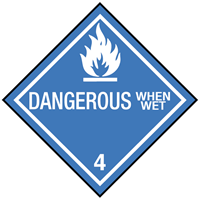
 Print
Print
Chemical Datasheet
ALUMINUM ALKYLS |


|
Chemical Identifiers
| CAS Number |
UN/NA Number |
DOT Hazard Label |
USCG CHRIS Code |
|
none
|
|
- Spontaneously Combustible
- Dangerous When Wet
|
none
|
| NIOSH Pocket Guide |
International Chem Safety Card |
|
none
|
none
|
NFPA 704
General Description
A clear colorless liquid. Not a single compound ("alkyl" refers to a family of substitutent groups). Most probably either trimethyl aluminum or triethyl aluminum.
Hazards
Reactivity Alerts
- Strong Reducing Agent
- Water-Reactive
- Pyrophoric
Air & Water Reactions
Highly flammable. May ignite upon contact with air producing aluminum oxide fumes. Reacts violently with water to give aluminum oxide and alkanes (flammable hydrocarbons).
Fire Hazard
No information available.
Health Hazard
No information available.
Reactivity Profile
ALUMINUM ALKYLS are strong reducing agents. React violently with water, alcohols, phenols, amines, carbon dioxide, sulfur oxides, nitrogen oxides, halogens, and halogenated hydrocarbons, creating fire and explosion hazards [Handling Chemicals Safely 1980. p. 929].
Belongs to the Following Reactive Group(s)
- Metal Hydrides, Metal Alkyls, Metal Aryls, and Silanes
Potentially Incompatible Absorbents
No information available.
Response Recommendations
Isolation and Evacuation
No information available.
Firefighting
No information available.
Non-Fire Response
No information available.
Protective Clothing
No information available.
DuPont Tychem® Suit Fabrics
No information available.
First Aid
No information available.
Physical Properties
Chemical Formula:
data unavailable
Flash Point: data unavailable
Lower Explosive Limit (LEL): data unavailable
Upper Explosive Limit (UEL): data unavailable
Autoignition Temperature: data unavailable
Melting Point: data unavailable
Vapor Pressure: data unavailable
Vapor Density (Relative to Air): data unavailable
Specific Gravity: data unavailable
Boiling Point: data unavailable
Molecular Weight: data unavailable
Water Solubility: data unavailable
Ionization Energy/Potential: data unavailable
IDLH: data unavailable
AEGLs (Acute Exposure Guideline Levels)
No AEGL information available.
ERPGs (Emergency Response Planning Guidelines)
No ERPG information available.
PACs (Protective Action Criteria)
No PAC information available.
Regulatory Information
EPA Consolidated List of Lists
No regulatory information available.
CISA Chemical Facility Anti-Terrorism Standards (CFATS)
No regulatory information available.
OSHA Process Safety Management (PSM) Standard List
| Chemical Name |
CAS Number |
Threshold Quantity (TQ) |
| Alkylaluminums |
Varies |
5000 pounds |
(OSHA, 2019)
Alternate Chemical Names
- ALUMINUM ALKYL
- ALUMINUM ALKYLS
- TRIMETHYL ALUMINUM



 Print
Print

